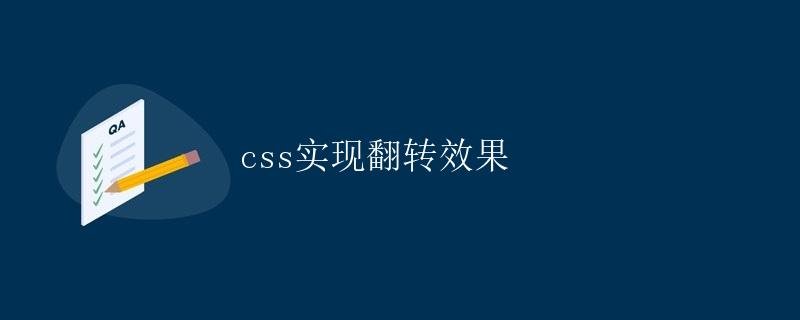CSS to achieve flip effect
CSS Flip Effect

In web development, cool flip effects are often used to add beauty and interactivity to the page. Using CSS, we can create various flip effects, such as page flips and card flips. This article will detail how to use CSS to achieve these effects and provide code examples for your reference.
Basic Flip Effects
First, let’s create a basic flip effect. We’ll create a card with two sides, and trigger the flip effect on mouse hover.
The HTML structure is as follows:
<div class="card">
<div class="front"></div>
<div class="back"></div>
</div>
Next, let’s add styles for the front and back of the card:
.card {
width: 200px;
height: 300px;
perspective: 1000px; /* Perspective effect, set perspective viewpoint distance */
position: relative;
transition: transform 0.5s; /* Add transition effect */
}
.front, .back {
width: 100%;
height: 100%;
position: absolute;
}
.front {
background-color: #3498db;
transform: rotateY(0deg);
}
.back {
background-color: #2ecc71;
transform: rotateY(180deg); /* Hide the back side by default */
}
.card:hover {
transform: rotateY(180deg); /* Flip to show the back side on hover */
}
In the above code, we use the perspective property to add a perspective effect to .card, creating a three-dimensional effect when flipped. We then add the .front and .back classes to the front and back sides of the card, respectively, and set different background colors. Finally, we use the :hover pseudo-class to set the flip effect on hover for .card.
Page Flip Effect
In addition to the basic flip effect, we can also implement a page flip effect, making the card appear to be turning pages dynamically as it flips. Below is a sample code to achieve a page flipping effect:
HTML structure:
<div class="page-flip">
<div class="page">
<div class="page-front">
Front Page
</div>
<div class="page-back">
Back Page
</div>
</div>
</div>
CSS style:
.page-flip {
width: 200px;
height: 300px;
position: relative;
perspective: 1000px;
}
.page {
width: 100%;
height: 100%;
position: absolute;
transform-style: preserve-3d;
transition: transform 0.5s;
}
.page-front, .page-back {
width: 100%;
height: 100%;
position: absolute;
backface-visibility: hidden;
}
.page-front {
background-color: #3498db;
transform: rotateY(0deg);
}
.page-back {
background-color: #2ecc71;
transform: rotateY(180deg);
}
.page-flip:hover .page {
transform: rotateY(180deg);
}
In the above code, we implement a page-turning effect similar to a flipbook. By adding the backface-visibility: hidden; property to .page-front and .page-back, we can avoid flickering during flipping. When the mouse hovers over .page-flip, .page will flip to reveal the backside.
Other Flip Effects
In addition to the flip effects described above, we can also use CSS to achieve more diverse flip effects, such as cube rotation and flip expansion. Below is a sample code to achieve a rotating cube effect:
HTML structure:
<div class="cube">
<div class="side front">Front</div>
<div class="side back">Back</div>
<div class="side right">Right</div>
<div class="side left">Left</div>
<div class="side top">Top</div>
<div class="side bottom">Bottom</div>
</div>
CSS style:
.cube {
width: 200px;
height: 200px;
position: relative;
transform-style: preserve-3d;
animation: spin 5s infinite linear;
}
.side {
width: 200px;
height: 200px;
position: absolute;
background-color: transparent;
}
.front { transform: rotateY(0deg) translateZ(100px); }
.back { transform: rotateY(180deg) translateZ(100px); }
.right { transform: rotateY(-90deg) translateZ(100px); }
.left { transform: rotateY(90deg) translateZ(100px); }
.top { transform: rotateX(90deg) translateZ(100px); }
.bottom { transform: rotateX(-90deg) translateZ(100px); }
@keyframes spin {
from { transform: rotateY(0); }
to { transform: rotateY(360deg); }
}
In the code above, we create a cube and assign different classes to each face. By setting different rotation angles and translation distances within the .side class, we achieve a rotation effect. Furthermore, we define a rotation animation using @keyframes to complete a 360-degree rotation in 5 seconds.
Through the above examples, we can see that CSS has powerful capabilities for creating flip effects, and by combining different properties and animations, we can create a variety of interactive page effects.